 |
| • products | • articles | • methodology | • projects | • bsc | • download | • news | • contact | • search |
Projects. Comprehensing information processing
Part 3. Search machine with time variant context
The standard machine for search with context (using SPW) doesn't take into consideration the fact that the phenomena, notions and contexts are time variant.
In the general case each specific (actual) moment of time sets its specific (actual) contexts.
For the search machine to take into consideration specific contacts pertaining to actual moments of time it is convenient to use
| subject-oriented elementary temporal context. |
As transition (movement) from one actual moment to another is described by an actual procedure it is a specific (actual) procedure that determines each new specific elementary temporal context. Then knowing only one of the phases of the phenomenon's movement in time (the state of the phenomenon) and the specific procedures makes it possible to predict and to restore the succeeding and preceding temporal contexts of phenomena and notions.
In order to carry out search in the information medium taking into consideration elementary temporal contexts and procedures connecting them it is essential to have:
- Procedures pertaining to the user (specified by the user).
- Procedures pertaining to the desired information.
- A framework for presenting the interaction of the procedures.
- A framework for presenting the interaction of the procedures with the contexts of the SPW.
A machine for information search based on the procedure connection of temporal contexts allows the user to set the features of the desired information just approximately. For instance, having presented the search machine with questions similar to the following ones: "what will happen?", "what happened?", "what may it look like?", "what is it like?", "what is the optimal way of doing it?", "how to avoid doing badly?" and so on, the user will be able to obtain what he needs. Elementary temporal context and the appropriate procedures are described in detail in the Addendum 3.1. Local procedure axis.
As the local procedure axis is itself in the user's (person's) temporal context this context can be taken into consideration by means of
| actualising the time in the SPW. |
Actual time is the time that corresponds (is synchronous with) to the user's time (subject-oriented time).
Actualization of time is achieved by the fact that
- Each moment of actual time corresponds to a specific actual SPW with specific actual phenomena.
- Actual SPW are interconnected by specific actual procedures.
Presentation of the SPW and their movement with actual time are described in detail in the Addendum 3.2. SPW in actual time - SPW(t).
A peculiarity of the machine with the SPW in actual time is that it is capable not only of carrying out the function of search but also of solving other information problems (induction, deduction, etc.). However it requires appropriate protocols of operation control of the machine. Such protocols determine various possible functional uses of the machine. The structure of the machine operating by particular protocols is shown in the Addendum 3.3. Standard machine of context.
Unlike the machine described in the Part 2 operating the ontological information only, the machine with time actualization makes it possible to operate in the actual medium and in the actual time regime.
Addendum 3.1. Local procedure axis
1. Basis of elementary procedure context.
2. The pair "theory-practice".
3. Complete picture of elementary procedure context.
1. Basis of elementary procedure context.
It is convenient to use a certain procedure pair, such, for instance, as "ideal-real" or "information-reality" or "theory-practice" as the basis for an elementary procedure context. Which pair to choose for the basis is really of little significance, as when such phenomena as "ideal", "information" or "theory" are presented as modules of elementary sense the similarity of their axes becomes evident. What is significant is the contradiction between the elements of the pair.
Each element of such a pair, when it manifests itself as an independent phenomenon, possesses its own context of formation (see Addendum 2.2, Context of formation).
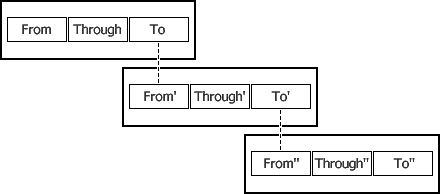
This allows each element of the pair "ideal-real", "information-reality", "theory-practice" to be presented as a sequence of procedures determined by the context of formation.
For instance, for pair "theory-ptactice",
| communication perception measurement evaluation reflection mentality proof order |
The phase of movement of the theory. | ||
| communication` perception` measurement` evaluation` reflection` mentality` disproof` denial` |
The phase of "degradation" of the theory (anti-result) or the phase of accumulation of resources of formation. |
||
| communication`` perception`` measurement`` evaluation`` reflection`` mentality`` proof`` order`` |
The phase of logical development (movement) of the "new" system (new theory) with regard to the context of formation (phase of "degradation" or that of "formation"). | ||
| input orientation energizing structurization organization creation output |
The phase of movement of the practice. | ||
| input` disorientation` disenergizing` destructurization` disorganization` annihilation` output` |
The phase of "degradation" of the practice (anti-result) or the phase of accumulation of resources of formation. |
||
| input`` reorientation`` re-energizing`` restructurization`` reorganization`` recreation`` output`` |
The phase of logical development (movement) of the "new" system (new practice) with regard to the context of formation (phase of "degradation" or that of "formation"). | ||
Notes.
a) It doesn't matter much what phenomena this sequence of procedures is constructed of, as here too the principle of similarity of phenomena is in operation. What is important is the changing of phenomena and their conversion into one another (FROM--THROUGH--TO). To meet the demands of various specific search machines the axes can take one or another specific initial form.
b) Each element of the axis pertaining to theory or to practice can itself make up a pair "theory-practice" and then unroll in a similar way.
2. The pair "theory-practice".
The pair "theory-practice" corresponds to movement that encloses practice the results of which, in the general case, correct theory and cause its transformation into "theory`". "Theory`" in turn leads to the initiation of "practice`" (practical actions) and so on. Then the pair "theory-practice" can be presented as the process of mutual conversion:
... -- theory -- practice -- theory` -- practice` -- ...
Note.
The pair "theory-practice" is the most general case but in certain specific cases, for ontological processes in particular, the "theory" may disappear - roll up into the "practice" of interaction of resources or converge into the information process.
With regard to the context of formation that each of the elements of the pair possesses, it is convenient to present the movement as formation of phenomenon:
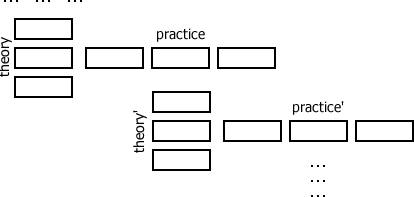
Then the process of operating the SPW with regard to elementary procedure contexts can be presented in the following way: one SPW is located above the other SPW, while they are linked by the procedure and so forth.
Example. "The doctor tells the mother to give the child a bath".
SPW1 is the picture of the world with the center in the phenomenon "doctor tells",
SPW2 is the picture of the world with the center in the phenomenon "giving the child a bath".
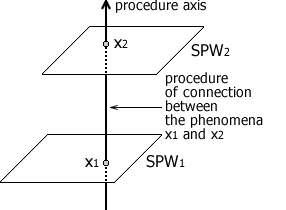
Where x1 and x2 are the phenomena linked by procedure connection.
Now it is necessary to determine what procedure connects these phenomena. Initially two procedures are given: "tell to" and "give a bath". Using the approach described in Part 1 we determine that to "tell to" is a procedure pertaining to information process (theory) and to "give a bath" is a practical procedure, the latter belonging to the subsystem of the former. Thus we have the procedure axis of the theory. It remains to determine what part of the procedure axis the procedure to "tell to" belongs to. Accordingly we get the possible locations:
| communication perception measurement evaluation reflection mentality proof order |
|||
| communication` perception` measurement` evaluation` reflection` mentality` disproof` denial` |
|||
| communication`` perception`` measurement`` evaluation`` reflection`` mentality`` proof`` order`` |
|||
We have got several possible positions where our specific procedure could be found. It means that our initial information is not sufficient for precise determination of the position of the procedure. To locate it more precisely it would be necessary to undertake a dialogue with the user (or interaction with the information medium) and find out what events, for instance, preceded the appearance of the initial communication. The conclusion would be made based on the answer.
A search machine using SPW (structural connections of a phenomenon) and elementary procedure context (procedure connections between phenomena) is constructed analogously.
Such a search machine with elementary procedure context does not require precise specification of what has to be found. Setting context procedure coordinates of the desired information ("what will happen", "what happened", "what it may look like", "to what it is similar" and so on) would be enough for it.
3. Complete picture of elementary procedure context.
It is worthwhile to evolving elementary procedure context more extensively with regard to teleological movement which would permit not to limit it (this context) only by the chain "...--theory--practice--...".
a) If we consider the movement
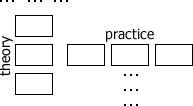
as a phenomenon, here there exists its own process of formation-degradation immanently pertaining to the pair "theory-practice". It is characterized by the fact that correction of the movement affects only the process of the movement but not its result. In the general case, if the control over the movement is reduced to this process only, we get the anti-result: each cycle "theory-practice" is resulting (formation) whereas the overall result might of any sort whatsoever (degradation). In other words, it is essential to take into consideration the supersystem context for the formation of the movement "...--theory--practice--theory`--...". It can be presented as follows:
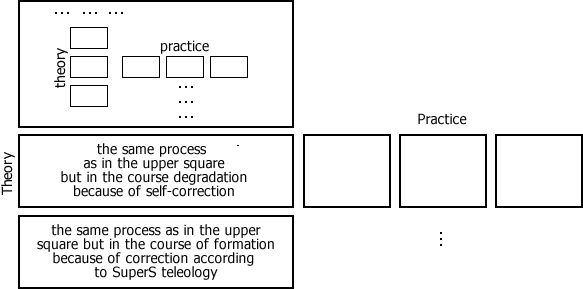
Let us get back to the example with giving a child a bath. The doctor explains everything properly to the mother. The mother gives her child a proper bath. But not allowing her baby to play with a sponge she does not promote development of the ability to take care of herself in her baby.
b) On the other hand, if the above described movement is regarded as an independent phenomenon, it too has, in turn, its own in immanent process of formation-degradation the essence of which is in the fact that correction of the movement occurs only by the criterion of "goal" of this movement. In the general case, if the movement is controlled only in its goal it ends up with the anti-result (degradation), as in the course of movement towards the goal the resources of the ambient systems and phenomena are uncontrollably consumed it finally leads to exhaustion of resources and inability to obtain the end result (to achieve the set goal). The problem lies in the lack of criteria by which it could be found out what resources might prove indispensable for future formation. The solution of this problem on the macro-level would be to accumulate and protect the ambient resources a priori as there is no way to predict which of them will be called for in future in the course of development of the current situation.
Hence is the a priori demand to abstain from exhausting resources (not to parasitize) but to create them instead (to move on accumulating resources in the meantime). This demand is made at each level of the process "theory-practice" and its fulfillment secures formation of complete elementary procedure context.
As a result we have three coils of formation of procedure contexts:
- Formation of a phenomenon.
- Formation of a process.
- Formation of a system of processes (based on the principle of creation of resources).
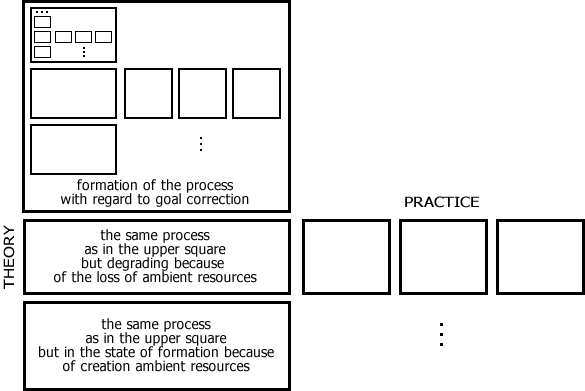
Let us get back to the example with giving a child a bath. The mother instills the skills of taking care of herself in her baby, but if she doesn't use other toys while giving her baby a bath or doesn't play with her in the meantime the overall development of the child is hindered.
Addendum 3.2. SPW in actual time - SPW(t)
1. Phenomenon and its actual time, actualization of a phenomenon.
2. Actual phenomenon movement with time (actual phenomenon).
3. Peculiarities of movement of the SPW with actual time.
The principle of procedure context movement of a phenomenon - that of local procedure axis was described in the Addendum 3.1. Now, owing to actualization of time, we have all the phenomena of the SPW moving at once as at every given (actual) moment all the phenomena of the SPW are characterized by their specific actual state. The procedure axis becomes universal it operates all the phenomena in their interference.
The SPW appears as an essence and its movement with time as a phenomenon of this essence. Accordingly the movement in time corrects the SPW itself (as Hegel put it: the essence develops, the form is realized).
1. Phenomenon and its actual time, actualization of a phenomenon.
Actualization of a phenomenon time wise corrects the features of the said phenomenon, eliminates invariants, giving it a more specific shape and rending univocal the axes of its module of elementary sense. As a result the module of elementary sense passes from the immanent into an actual state. Module editing occurs in the manner analogous to the definition of a noun by its adjective (see Addendum 1.1). The same applies to a context module.
2. Actual phenomenon movement with time (actual phenomenon).
The procedure axis describes the movement of a phenomenon with time and already comprises the phenomenon formation. Them the movement of a phenomenon with time can be presented in the form of two layers: SPW(t1) and SPW(t2) representing the actual phenomena at the given moments of time t1 and t2 respectively. The layers SPW(t1) and SPW(t2) are interconnected by the intermediate third one i.e. procedure layer.
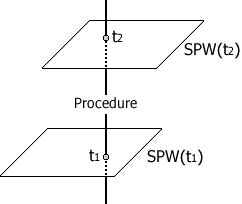
The general view of the SPW movement with can be presented as a pile of layers
... -- SPW (t-1) -- SPW (t) -- SPW (t+1) -- ...
With their elements connected by procedures.

3. Peculiarities of movement of the SPW with actual time.
A temporal interval between events is relative time. Relative time can be evaluated only from the comparative point of view, for instance the period from t-1 to t is shorter than that from t-1 to t+1.

If reference time is introduced i.e. each layer of the SPW(t) is labeled in real time: year, month, date, hour, minute, second and so on and special procedures are introduced for registration and comparison of reference time for various events it makes it possible to construct a machine operating not only structural and procedure contexts but also temporal contexts.
Note.
It was only the so-called A-logic of time (according to A.N.Prior) we used when operating the procedure context axis. The A-logic implied "past--present--future" with the actual phenomenon belonging to "the present" and the procedure contexts working with "the past" and "the future". With actualization of time there appears a possibility of using the B-logic of time operating such notions as "previously--simultaneously--subsequently", which gives an opportunity to trace the movement and the interrelations of the phenomena of the SPW(t) in real time. This affixment of the SPW(t) to actual time makes it possible to get rid of an infinite number of possible procedure contexts.
Addendum 3.3. Standard machine of contexts
If the machine described in the Addendum 2.3 is to be regarded as a prototype, the standard machine of contexts has its principal differences:
1) Movement of the SPW with time makes it possible to operate not only structural and procedure contexts but also temporal contexts.
2) As we have at our disposal in the SPW(t) the interaction of such universal contexts as formation, structure, procedure and time we can also work with any particular context we are interested in. Take, for instance, the Aristotle's contexts: essence, quantity, quality, relation, place, time, position, possession, acting, undergoing, and movement.
Let us take a look at it using the following example.
The distance between the point A to the point B can be presented through the properties of the phenomenon "car" possessing the property of speed and of the phenomenon "time required for moving from A to B". The distance is the product of speed and time. Assuming that the points A, B and C are each regarded as vertex of triangle, the same can be applied to the distance between A and C. However, the distance between B and C is present here too though in the implicit form, but it can be revealed if such properties of phenomena as "direction", "longitude", "latitude", "angle" are added into consideration. In this case any desired information will be potentially present in the machine with temporal context, the information concerning the space of phenomena in particular (as, let's say, as information from the past). To operate the necessary categories realization of the appropriate procedures would be necessary, as, for instance, determining distance
with the help of trigonometric formulas.
The standard machine of contexts will look exactly as the one described in the Addendum 2.3 but with a functional unit containing operational procedures for specific categories each with its contexts depending on the objective of the machine.
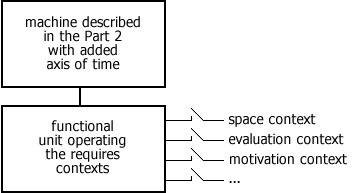
The structure of such contexts as notion, judgment and conclusion is analyzed in detail in Hegel's work "Science of Logic", volume 2 "Subjective logic or the studies about notion".
Next: Part 4. Machine of categories. Two machines interaction ![]()
Copyright (C) 2001-2025 INTELLECTUAL PARTNER. All Rights Reserved.